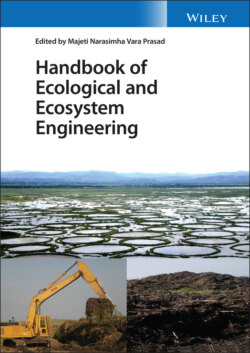Читать книгу Handbook of Ecological and Ecosystem Engineering - Группа авторов - Страница 38
3.3 Practice and Implication of Ecological Engineering
ОглавлениеA Newtonian approach alone may not be sufficient in formulating the design and principles of ecological engineering while framing a sustainable system. A balance between the domains of ecology, engineering, and design proposes a sustainable system model including an open living ecosystem that coexists with societal development. Traditional ecological knowledge3(TEK) and practices may prove to be revolutionary alternatives in generating thought‐provoking ideas for managing and restoring the environment by designing sustainable ecological engineering methods [2]. TEK has been practiced by indigenous and local populations to meet socioeconomic requirements since ancient times. With the integration of new techniques and concern about the environment, these practices have evolved over the years to ensure ecosystem sustainability and conservation. A World Commission on Environment and Development [62] report stated, “Local communities are the repositories of vast accumulations of traditional knowledge and experience that links humanity with its ancient origins. Their disappearance is a loss for the larger society, which could learn a great deal from their traditional skills in sustainably managing very complex ecological systems.” For more complex ecosystems with living and non‐living sections, a Newtonian worldview should embrace an organic approach to extend its boundaries. Traditional engineering, however, may not be successful in a natural system that depends on controlled distribution imposed on the environment and emergent behavior of the system during ecosystem management and design.
The practice of ecological engineering has been observed in various ecosystems with self‐design models and sustainability. Several large projects around the world have been designed based on these concepts: in the eastern part of the United States, restoration of salt marshes on Delaware Bay [45, 54]; river restoration in Jutland, Denmark, with farm and civilization protection [44]; reduction of nitrogen loading in the Gulf of Mexico [36]; restoration of Southeast Asian tropical mangroves [3]; and Mississippi River delta restoration [11, 12]. Mitsch [32] showed that well‐designed ecological engineering following oil spills in the Gulf of Mexico is more important than a traditional engineering approach that resulted only in wasting money and resulted in great harm to the ecosystem.
Practical approaches to ecological engineering are supported by programs and academic discussions. North American universities have developed several such programs: a separate environmental and ecological engineering department has been set up at Purdue University, Oregon State University has renamed its agricultural engineering department to biological and ecological engineering, and the University of Florida offers graduate‐level courses on ecological engineering. Other universities, such as the University of California Davis, Ohio State University, and McGill University, have special programs designed for students in this discipline.
